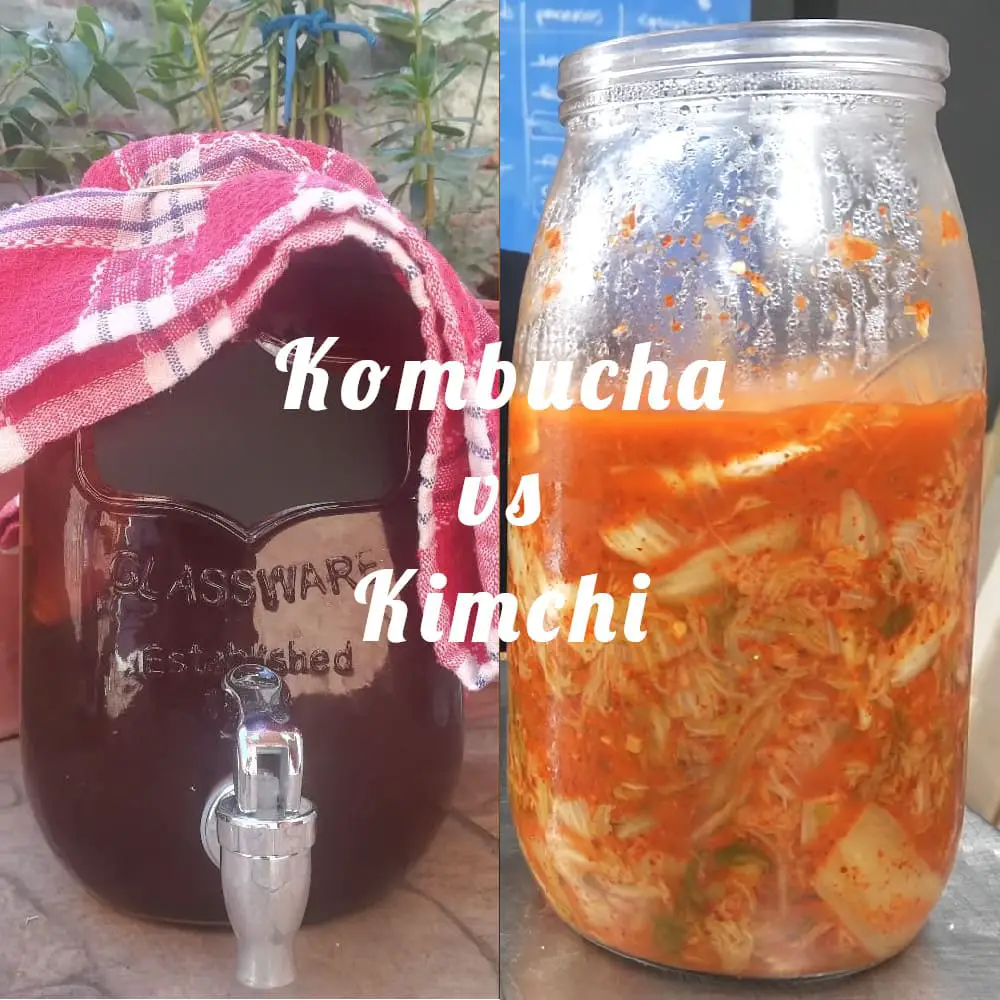Kimchi and kombucha are probiotic foods fermented through different microorganisms such as bacteria and yeasts whose product is essential for health. Both are known and consumed throughout the world for their beneficial properties to the body.
UNESCO has included the traditional preparation of kimchi as “Intangible Cultural Heritage of Humanity”[1]. Nowadays the possibility of using fruits and vegetables as a vehicle in the growth of probiotic microorganisms is given great value.
According to the ” Journal of Food Science” (Critical Reviews in food science and nutrition)[2] indicates that fermented foods such as these probiotics are essential for strengthening the immune system.
So it is important to know its origin, benefits, the different microorganisms for its elaboration and the whole fermentation process that entails to successfully give these products in which even the Michelin chef include in their culinary recipes today.
What do kimchi and kombucha have in common?
Kimchi and kombucha have certain characteristics in common, starting from their origin that they come from the Asian continent, but in different countries. In addition, both contain probiotics that may have a potential effect on the control of certain diseases.
However, the strains of probiotics needed to make these products are different and later in this article we will address this topic in more detail.
The benefits are also similar, since both are ideal for the intestinal part, to strengthen the immune system and are low in calories because no lipids are present in their preparation.
As for their nutrition, both have high levels of vitamins and minerals that gives us strengthening in different tissues of the body such as nails, skin, hair, among other aspects of relevance.
One of the aspects that are detailed in Asians, is the ability they have to have a fairly long life, that is, the existence of several elderly people to reach 100 or more years of life compared to people in the West.
It is speculated that the reason behind this fact is the daily consumption of fermented foods and beverages product of the positive effect of probiotics, although much more research is required in this regard.
Both kimchi and kombucha possess ANTIOXIDANT properties that slow down premature aging. [3] [4]
What are the benefits of kimchi and kombucha?
Both have benefits because in their fermentation process metabolites are generated that contribute to the improvement of the quality of life.
Among the benefits in general we have:
- It helps digestion, as it cleanses the intestines thanks to its lactic acid content.
- They prevent intestinal cancer due to their protective effect of the intestinal mucosa, increasing mucus production and detoxification by decreasing pro-carcinogenic bacteria. [5] [6]
- It reduces cholesterol by being low in calories. [5]
- They have antioxidant and anti-aging properties.
- They are rich in Vitamin C and vitamins such as B1, B2, B3, B6 and B12.
- Contain Minerals such as Iron, Zinc, Magnesium, Copper, and Calcium
Contraindications of kimchi and kombucha
Like any other food, there are certain contraindications in the consumption of both foods that can turn the benefits into problems.
I want to note with this that it is not that these foods are bad, but that you have to have certain safeguards regarding their intake, in the same way that they should be had with nuts regarding their caloric content or allergies.
Kimchi should be avoided in people:
- Irritable bowel syndrome due to the consumption of spicy, usually this type of food contains a large amount of hot pepper.
- Hypothyroidism not controlled by the presence of iodine in food.
- High blood pressure not controlled by salt intake.
- Immunosuppressed because microorganisms with low defenses could become opportunistic and therefore trigger unwanted effects.
Kombucha should be avoided in people:
- In childhood under 6 years due to the immaturity of the intestines at their young age to ingest this type of drink, but mostly because of the alcohol content.
- In children over 6 years there are no 100% proven studies about its benefit or effects that may cause ingesting this drink, however there are studies that support diluting it with water or in a fruit juice for consumption.
- In pregnant and lactating women this drink can cross the placental barrier during pregnancy, or through the breasts having laxative effects.
- In the same way as kimchi, in immunosuppressed by the relative explanation above of kimchi.
Recommended Dosage to Consume of Kimchi and Kombucha
According to the World Health Organization (WHO), [7] it defines probiotics as those live microorganisms that, administered in the right amount, can have numerous benefits.
The consumption of fermented foods and beverages should be a habit of life and consume daily.
Kimchi: it can be eaten at all times from breakfast to dinner as an appetizer, however, about 2 or 3 tablespoons in the day is an adequate amount to consume, many times this food is used as a garnish or starter dish in restaurants.
Kombucha: being a natural drink, it starts with a daily intake of “120 to 360 ml” distributed before the main meals. In case of diabetes, consumption can be in less quantity per day, so as not to alter blood glucose levels due to the sugar added to kombucha.
I invite you to check out our recommended dosage article or the best times to drink kombucha.
Are the probiotics in kimchi and kombucha the same?
It can be said that both probiotics have some similarity as long as the specific lactic acid-producing bacteria are used, but they are not the same because they have other different types of microorganisms that do not produce lactic acid as such but are considered probiotic because they have the same beneficial properties for health.
In the case of kimchi, one of the microorganisms with the highest lactic acid productivity is the presence of Lactobacillus plantarum and Lactobacillus sakei found in napa cabbage, among other vegetables. [8]
In the case of kombucha, Schizosaccharomyces, Saccharomyces cerevisiae, Acetobacter and more. [9]
However, the lactic acid in kombucha is not present in all cases, so it relies heavily on the SCOBY itself. Kombucha has higher concentrations of acetic and gluconic acid.
Finally, it can be mentioned that both feature probiotics important for gut health.
Main differences: Kombucha vs Kimchi.
Although we have said they are similar products, both have characteristics that are far from it, so from now on we will describe their differences according to certain criteria. These criteria are as follows:
Origin
Kombucha is an ancestral drink of Chinese culture and in 221 BC in which it spread through Japan, Russia, and Europe.
Kimchi is a type of food that was developed by farmers in Korea in which it began to be consumed more than 1,500 years ago. It is a Korean food.
Raw material and its preparation
Kimchi: the raw material used as the main ingredient is napa cabbage or also called cabbage.
The elaboration process begins with a base of dried nappa cabbage with salt, and accompanied by other raw vegetables in which the ingredients are cleaned, cut into a pickle, seasoned with spices, and stored in plastic or glass containers to keep at room temperature or in a special refrigerator for kimchi for 2 months or more.
Kombucha is a drink that can be made at home in which its raw material as the main ingredient is black or green tea, this liquid is added a symbiotic culture of bacteria and yeast is added sugar for fermentation is placed in a glass container covered with a cloth that allows air circulation without letting dust or insects enter and the mixture is left resting for a week or more.
Microorganisms
Kimchi contains the following bacteria: Leuconostoc (Lk.) mesenteroids, Lactobacillus (Lb.) sakei, Weissella (W.) koreensis, Lc. gelidum, Lk. carnosum, and Lc. Gasicomitatum. [10]
Kombucha: the following bacteria are present: Acetobacter xylinum, Gluconobacter bluconicum. And of the yeasts identified as: Schizosaccharomyces pombe, Saccharomyces cerevisiae, Zygosaccharon bailii, Kloecera apiculata, Brettanomyces bruxellensis, Brettanomyces lambicus, Brettanomyces Custersii, candida stellata.
Fermentation conditions
For kimchi, a temperature between 25 and 28 ° C is required, which requires a fermentation time of 3 to 7 days.
Kombucha is fermented with an average ambient temperature of 21 to 27 ° C that requires approximately 7 to 15 days of time to finish fermenting.
Taste
Kimchi has a salty and spicy flavor due to the addition of salt and chili pepper to the preparation, without neglecting that acid flavor, very similar to sauerkraut.
Kombucha has an acidic taste similar to vinegar, but still feels the sweetness of sugar, so it also has a similar feeling to apple cider.
Colour
The kimchi is reddish in color due to the pigmentation of the hot paprika and the chili pepper that is added.
The kombucha has that reddish color of the tea, which with fermentation is lightened towards an orange.
Texture
The texture of kimchi is crunchy that is inherited from cabbage, plus this is a fermented food.
Kombucha on the other hand is a fermented drink, therefore it has a liquid texture that is effervescent.
Aroma
The aromas of kimchi are quite unique, as when seasoned with various spices, it takes on an acid-like aroma mixed with aromatic herbs.
Kombucha has a very acidic smell reminiscent of vinegar, and it is such an important aspect that many people know the exact point of kombucha based on how it smells.
In short
We will clarify some of the main differences in a comparative style chart to make it clearer and more concise for readers.
| FEATURES | KIMCHI | KOMBUCHA |
| Origin | Korea | China |
| Raw material | Cabbage napa or cabbage | Black or green tea |
| Microorganisms | Bacteria and yeasts | Bacteria and yeasts |
| Fermentation time | 3 to 7 days | 7 to 15 days |
| Fermentation temperature | 25 to 28°C | 21 to 27°C |
| Taste | Salty and spicy | Acidic or slightly sweet |
| Aroma | To aromatic herbs | Slightly vinegary |
| Colour | Reddish | Brown or reddish |
| Texture | Crusty | Liquid |
| Calories | Low calorie | Low calorie |
| Composition | Solid by the presence of cabbage | Liquid by the presence of Tea |
| Recommended dose | 2 to 3 tablespoons a day as a garnish | 120 to 360 ml daily |

